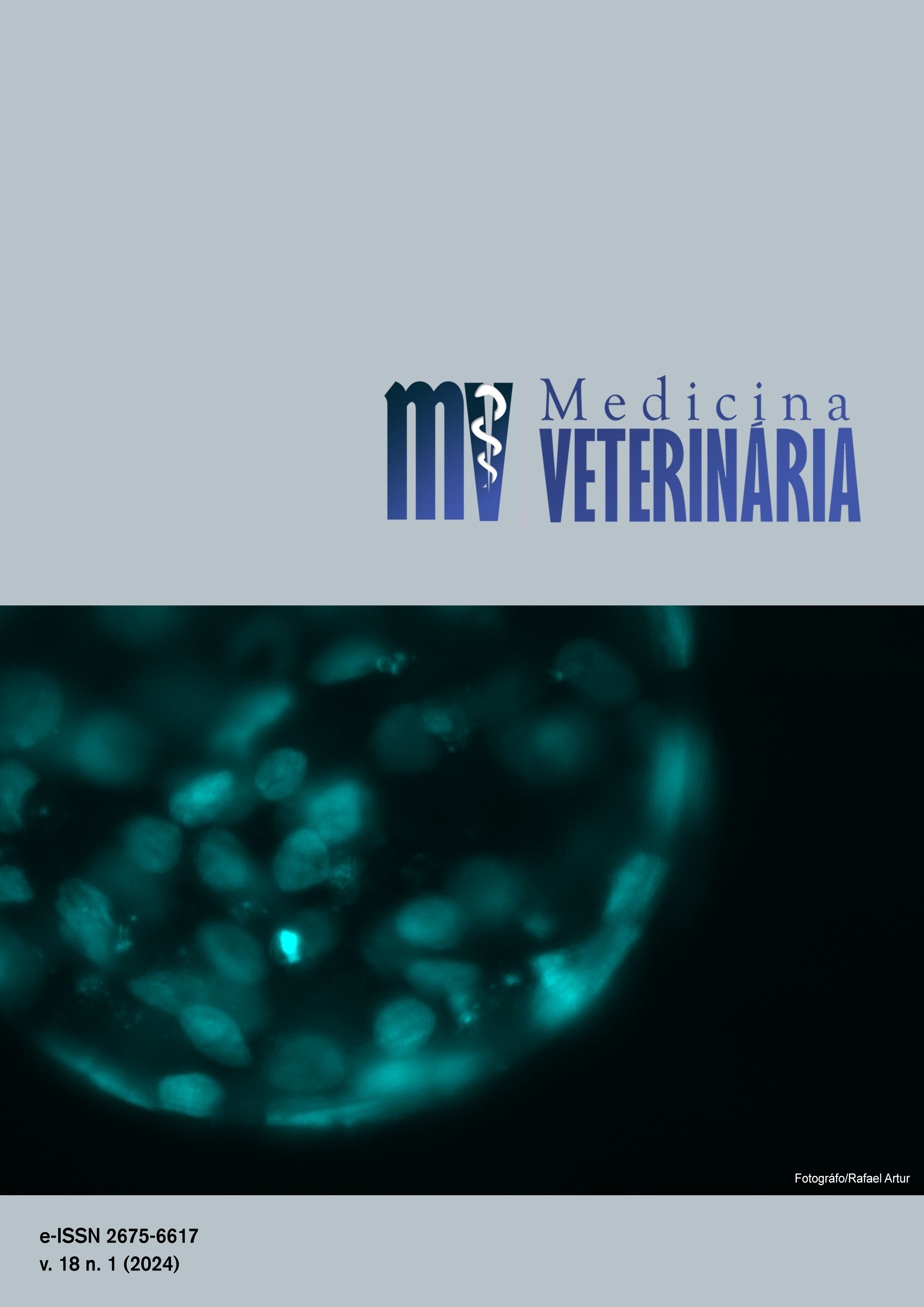Descriptive anatomy of the bony orbit of tropical-sreech-owl (Megascops choliba)
DOI:
https://doi.org/10.26605/medvet-v18n1-6171Keywords:
birds, animal morphology, eye, osteology, strigiformAbstract
The cranial anatomical particularities of birds are fundamental to understanding the phylogenetic aspects, contributing to the identification of species and understanding of the animal's life habits. Regarding the veterinary clinical context, knowledge of the cranial region becomes even more essential in the more accurate care of these animals, especially in the analysis and reliable interpretation of image exams. Thus, the objective of the present research was to macroscopically describe the bone orbit and the bone accidents in the tropical-sreech-owl (Megascops choliba), using 15 adult specimens, undetermined sexes arising from natural deaths from the Veterinary Hospital of the Federal University of Paraná-Palotina Sector. All animals were dissected for their skulls to be macerated in water. Subsequently, these were immersed in a hydrogen peroxide solution and exposed to the sun. For analysis and description, a circular magnifying glass with cold light and an unarmed eye was used. Thus, it was observed that the orbit was elongated in the rostrocaudal direction with the presence of short supraorbital prominence, wide postorbital process, incomplete suborbital arch, and thin interorbital septum with several foramina, in which the most significant proportion was the foramen of the optic nerve. Thus, based on the analyzes carried out, a more detailed description is provided with new contributions to the descriptive anatomy of the bone orbit of the native species of owl, M. choliba, in which the need to understand more assertively the uniqueness of the anatomy of the bone orbit between different avian species and their comparative anatomy stands out.Downloads
References
Arent, L.R. Anatomia e Fisiologia das Aves. In: Colville, T.; Bassert, J.M. (Org). Anatomia e Fisiologia Clínica para Medicina Veterinária. 2ª ed. Rio de Janeiro: Elsevier Saunders, 2010. p.414-454.
Baldotto, S.B. et al. The crested caracara (Caracara plancus) eye: Morphologic observations and results of selected diagnostic tests. Veterinary Ophthalmology, 24(5): 533–542, 2021.
Bavdek, S.V. et al. Skull of the grey heron (Ardea cinerea): Detailed investigation of the orbital region. Anatomia, Histologia, Embryologia, 46(6): 552–557, 2017.
Baumel, J.J. et al. Handbook of Avian Anatomy: Nomina anatomica avium. 2a ed. Massachusetts: Nuttall Ornithological Club, 1993. 401p.
Carvalho, C.M. et al. Avian ophthalmic peculiarities. Ciência Rural, 48(12): 1-10, 2018.
CBRO. Comitê Brasileiro de Registros Ornitológicos. Listas das aves do Brasil. 2021. Disponível em: <http://www.cbro.org.br/wp-content/uploads/2020/06/avesbrasil_2014jan1.pdf>. Acesso em: 21 de ago 2023.
Cubas, Z.S.; Silva, J.C.R.; Catão-Dias, J.L. Tratado de animais selvagens: Medicina Veterinária. 2a ed. São Paulo: Editora Roca, 2014. 2492p.
Del Hoyo, J.; Elliott, A.; Sargatal, J. Handbook of the birds of the world, v. 5. Barcelona: Lynx Edicions, 1999. 759p.
Dyce, K.M.; Wensing, C.J.G.; Sack, W.O. Tratado de anatomia veterinária. 4a ed. Rio de Janeiro: Elsevier, 2010. 834p.
IUCN. International Union for Conservation of Nature. The IUCN Red List of Threatened Species. Versão 2021-3. 2021. Disponível em: <https://www.iucnredlist.org/species/22688774/167849732>. Acesso em: 21 ago. 2023.
König, H.E.; Liebich, H.G. Anatomia dos Animais Domésticos. 7a ed. Porto Alegre: Artmed, 2021. 856p.
Machado, M.; Dos Santos, E.M.S.; Montiani-Ferreira, F. Interspecies variation in orbital bone structure of psittaciform birds (with emphasis on Psittacidae). Veterinary Ophthalmology, 9(3): 191–194, 2006.
Menegaz, R.A.; Christopher, E.K. Septa and processes: convergent evolution of the orbit in haplorhine primates and strigiform birds. Journal of Human Evolution, 57(6): 672–687, 2009.
Mikkola, H. Owls of the Worl: A Photograpic Guide. London: Firefly books, 2019. 528p.
Pycraft, W.P.I.A Contribution towards our Knowledge of the Morphology of the Owls. Part II.-Osteology. Transactions of the Linnean Society of London, 9(1): 1-46, 1903.
Rodarte-Almeida, A.C.V. et al. O olho da coruja-orelhuda: observações morfológicas, biométricas e valores de referência para testes de diagnóstico oftálmico. Pesquisa Veterinária Brasileira, 33(10): 1275–1289, 2013.
Sick, H. Ornitologia Brasileira. 2nd ed. Rio de Janeiro: Nova Fronteira, 1997. 862p.
Willis, A.M.; Wilkie, D.A. Avian ophthalmology part 1: anatomy, examination, and diagnostic techniques. Journal of Avian Medicine and Surgery, 13(3): 160-166, 1999.
Downloads
Published
How to Cite
Issue
Section
License
Copyright (c) 2024 Luana Celia Stunitz da Silva, Julia Vulpini de Moraes, Ketlyn Christine Bonatto Perlin, Christopher Frigo

This work is licensed under a Creative Commons Attribution-NonCommercial-ShareAlike 4.0 International License.
A Revista de Medicina Veterinária permite que o autor retenha os direitos de publicação sem restrições, utilizando para tal a licença Creative Commons CC BY-NC-SA 4.0.
De acordo com os termos seguintes:
Atribuição — Você deve dar o crédito apropriado, prover um link para a licença e indicar se mudanças foram feitas. Você deve fazê-lo em qualquer circunstância razoável, mas de nenhuma maneira que sugira que o licenciante apoia você ou o seu uso.
NãoComercial — Você não pode usar o material para fins comerciais.
CompartilhaIgual — Se você remixar, transformar, ou criar a partir do material, tem de distribuir as suas contribuições sob a mesma licença que o original.
Sem restrições adicionais — Você não pode aplicar termos jurídicos ou medidas de caráter tecnológico que restrinjam legalmente outros de fazerem algo que a licença permita.







